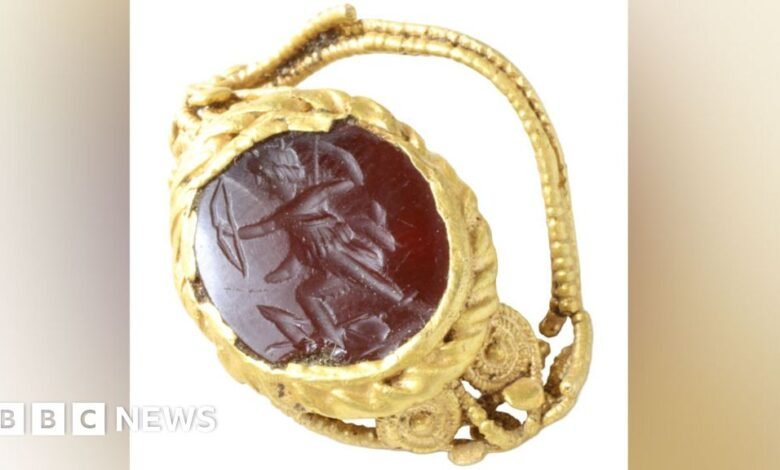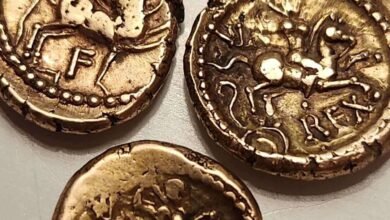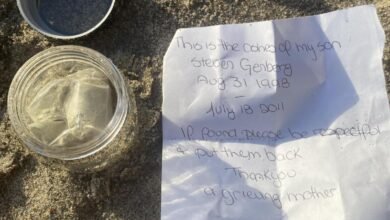Norfolk is treasure capital for detectorists, the museum says

- By Katy Prickett
- BBC News, Norfolk
image source, Andrew Williams/Norfolk County Council
More treasures were discovered in Norfolk than any other county in 2022, according to new figures.
Metal detectors reported 95 finds in the county, compared to 83 in Hampshire and 81 in Kent.
The British Museum, which runs the Portable Antiquity Scheme (PAS), said 2022 was a “record year” for reported finds.
Mark Jones, interim director of the museum, thanked “the metal detecting community” who volunteered to record the finds.
With more than 5,101 finds, Lincolnshire had the most finds overall – apart from items classified as treasures only. Norfolk had 4,265 and Suffolk 2,727.
image source, The Trustees of the British Museum
There are a number of reasons why Norfolk remains at the top of the treasure list, according to Helen Geake, the county’s finds liaison officer.
“Norfolk has always been a very wealthy county, particularly in times when wealth depended on agriculture,” she said.
“It’s also very large, not very urban and very heavily plowed so things that are lost can be found and things that are buried can be eroded down to the topsoil and found.”
“And thirdly, we have been working with metal detectors for a long time and have a large team. So if something is found in Norfolk, people here know what to do.”
image source, Andrew Williams/Norfolk County Council
A gold Roman ring with a red gemstone engraved with a figure of the goddess Diana was among the 2022 Norfolk treasure trove discovered at Sedgeford, near King’s Lynn.
Since the Romans gave and received wedding rings, according to Dr. Geake could also have been a token of love.
image source, The Trustees of the British Museum
The British Museum also announced some “significant” new finds since 2022, including a Late Bronze Age dress clasp.
The 3,000-year-old object was found by detector specialist Jonathan Needham in Staffordshire and is believed to have been used to fasten clothing.
Museum scientist Laura Perucchetti and curator Neil Wilkin examined the find and it is likely that it will be acquired by a museum.
What is a treasure?
- According to the Treasure Act 1996, the term “treasure” includes prehistoric objects, coins containing gold or silver that are at least 300 years old, or more recent valuable objects that have been deliberately hidden
- Finders of potential treasures in England, Wales and Northern Ireland are required by law to notify their local coroner
- An investigation then determines whether the finds are treasure
- If the find is declared treasure, the finder must offer it for sale to a museum at a price determined by the Treasure Valuation Committee of the British Museum
- A reward is then offered to the finders and other relevant parties, including the landowner
image source, The Trustees of the British Museum
Another exceptional find was an Iron Age treasure containing 26 Iron Age gold coins hidden in a flint container.
It was discovered in East Garton in western Berkshire.
Pippa Pearce, senior conservator, said: “Each coin is a miniature document.”
“To understand it, it must be read, and the task of conservation is to make this possible and to reveal the hidden details beneath the concretions and corrosion that formed during burial.”
image source, Trustees of the British Museum
A third find announced by the museum was a carved rosary bead dating from between 1450 and 1550 that was unearthed in the City of London.
It is 27mm high and 21mm wide and features the face of a young woman on one side and a skull on the other.
Mr Jones said the finds recorded by the PAS “improve knowledge of ancient peoples, where and how they lived”.
“As such, it reflects every part of human history, from the Palaeolithic to modern times, across England and Wales,” he said.



